Inbound Marketing Commandment #5: You Must Have Someone Responsible
As part of the LeadG2 series on "The 10 Commandments of Inbound Marketing" we will look at each of these ten commandments and why these principles...


A few weeks ago, I was asked by one of my friends to speak to a gathering of business leaders about how they can generate more leads for their businesses. As I was discussing a presentation idea with my friend, he stopped me and said something that I found really insightful and that I wanted to share.
He said, “Brian, this might seem like common sense to you, since you do this everyday, but . . . what exactly is inbound marketing?” At first I was surprised at this question because I had just been asked to speak at an event by this person, and in the next breath they are asking me what it is that I do for a living.
Believe it or not, this is not the first time I have been asked this question and it’s asked frequently enough that I have a pretty standard response to the question of “What is Inbound Marketing?”.

(see also: "marketing that consumers don't hate" "content marketing" "lead generation")
Definition: Inbound Marketing is the process of attracting the attention of prospects, via content creation, before they are even ready to buy; it's one of the best and most cost-effective ways to convert strangers into customers and promoters of your business.
The challenge with defining inbound marketing is that it encompasses many things, including social media, content marketing, analytics, email marketing, marketing automation and many other components. The challenge that this creates for business owners and marketers alike is how to structure a plan that integrates all of these different components into one cohesive and effective inbound marketing strategy. This is where most businesses fail when it comes to inbound marketing. They lack a solid understanding of how all of the components work together and how to structure their content marketing, social media and email marketing into something that resonates and is effective with their target persona. They also lack the knowledge of what tools do what and how to integrate them or when to purchase an entire solution like HubSpot, Marketo, or Pardot.
Prospective clients don’t come to us because they have a inbound marketing plan that’s working! No, prospective clients come to us when they have no idea what they are doing, no strategy, or need a strategy before they get started.
Because we work with clients every day that are facing these same challenges, we have spent a lot of time putting together a structure and format for how to do inbound marketing the right way. The way that LeadG2 explains inbound marketing is by walking each of our clients through the 7-Step Lead Generation Strategy, which is a proprietary method we use to ensure our clients are seeing success with their inbound marketing.
Because we have a method to doing inbound marketing effectively, it’s much easier to explain to someone that’s unfamiliar with the concepts. This is the starting point for discussing inbound marketing and providing enough details so that someone can implement a plan on their own. From what we have experienced by speaking to a number of business owners and marketers about inbound marketing, it’s not as easy as it looks, and most companies would rather hire someone else to do it for them rather than trying to do it in-house. Either way, the key thing is to understand how inbound marketing can work for your business and what is required of businesses wanting to be successful with inbound marketing. Let’s just say you don’t build a successful inbound marketing program by chance, and it takes a good team running your program to make it a success.
If you want to know more about inbound marketing or arrange for someone to speak to your company’s leaders about how it can (or can’t) work for your business, let us know.

As part of the LeadG2 series on "The 10 Commandments of Inbound Marketing" we will look at each of these ten commandments and why these principles...

Many companies looking to implement a lead generation or inbound marketing program want to know the easiest and most cost-effective way to reach...

Anyone can wake up and decide that today is the day they are going to start an inbound marketing program at their company. But not just anyone can...